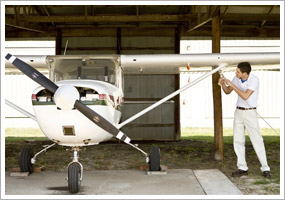| The following stories from the October 17, 2008, edition of AOPA ePilot were provided to AOPA members who expressed an interest in the particular subject areas. Any AOPA member can receive information tailored to their areas of interest by updating their preferences online. TRAINING TIPsPOSTFLIGHT
Postflight procedures encompass more than retracting the flaps and taxiing clear of the runway. Next come parking and shutdown. Then it's time to make decisions about servicing, refueling, and whether to have the aircraft moved under cover against frost or bad weather. A quality review of your lesson should come next. The habit of rushing off at the end of your flights because of a tight personal schedule spoils the productivity of flight training. Pay attention to postflight details and you will be less likely to forget to close your VFR flight plan—an added bonus.
Postflight procedures are examined on your sport pilot or private pilot flight test. This starts with the delicate process of decelerating after touchdown, under directional control, and adhering to "runway hold lines and other surface control markings." It includes your use of after-landing checklists and confirms that you ensure "the safety of nearby persons and property" while parking. Don't let a well-flown checkride go awry because of a mental letdown or casual postflight attitude. "Some examiners test at length their applicants' aircraft parking and securing knowledge during the oral exam. To an examiner, there is far more to parking and securing than simply pulling the mixture control to idle cutoff and flipping the master switch off. There is also applicant knowledge of hand signals, which appear in the Aeronautical Information Manual (AIM)," Dave Wilkerson advised in " Postflight Procedures" on AOPA Flight Training Online. Did the previous pilot forget to turn off the master switch, leaving you with a dead battery? Chip Wright gives tips for avoiding common postflight omissions in his July 2004 AOPA Pilot feature " Details, Details." And Leroy Cook's February 2008 AOPA Flight Training feature " Better Than You Found It" offers steps to take after flying that will speed you skyward on your next flight, while keeping you on the good side of maintenance personnel and your fellow pilots. TRAINING PRODUCTSSporty's E6B has three new functionsAn electronic E6B is a handy tool for pilots of all skill levels. Sporty's Electronic E6B Flight Computer now has three additional new functions to make life easier. The computer calculates required rate of descent (useful for instrument pilots), top of descent (which lets you know how far out in miles to start a descent), and specific range, which allows the user to calculate the most fuel-efficient cruising altitude, a useful function for long cross-countries. The Electronic E6B Flight Computer sells for $64.95 and may be ordered online or by calling 800/SPORTYS. |
 It happens: You come out to the airport ready to fly, only to find that your training airplane isn't. It turns out that someone else's thoughtless postflight procedures threaten to delay your flight, or even scrub it altogether.
It happens: You come out to the airport ready to fly, only to find that your training airplane isn't. It turns out that someone else's thoughtless postflight procedures threaten to delay your flight, or even scrub it altogether.

